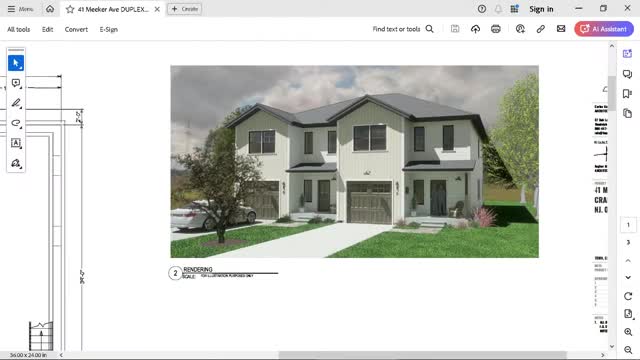Controversial renovation sparks debate over zoning variances
June 06, 2024 | Cranford, Union County, New Jersey

This article was created by AI summarizing key points discussed. AI makes mistakes, so for full details and context, please refer to the video of the full meeting. Please report any errors so we can fix them. Report an error »

In a recent government meeting, plans for a significant renovation of an existing residential building were discussed, focusing on converting it into a two-family dwelling. The proposed design includes modern features such as Hardiplank siding, a slate-colored asphalt roof, and upgraded garage doors, aiming to harmonize with neighboring properties.
The architectural plans revealed that the new structure will consist of side-by-side units, each featuring a basement of approximately 700 square feet, which will include a family area, bathroom, and mechanical closet. The ground floor will boast a spacious living room, kitchen, dining area, and a mudroom leading to the garage. The second floor is designed to accommodate two regular bedrooms, a master suite with a walk-in closet, and two full bathrooms.
However, the proposal has raised concerns regarding the attic space, which is intended to be used as a playroom. Board member Mr. Boire expressed that modifications to the roofline and the addition of windows could classify the attic as a third story, necessitating a variance. The architect confirmed that the highest point of the attic will be 7 feet, sloping down to 6 feet 6 inches, which complicates its classification under zoning regulations.
The discussion also touched on the potential for the attic to be used as a bedroom, prompting suggestions to lower the roof height to ensure it remains non-habitable. The board is considering whether these adjustments would alleviate the need for a variance while still allowing for adequate light and space.
Additionally, the meeting highlighted the need for compliance with building codes, particularly regarding the installation of bathrooms in the attic and the overall height of the structure. The architect assured that all modifications would adhere to local regulations, including the installation of sump pumps in the basement.
As the board deliberates on the proposal, they are also considering the character of the neighborhood, with some members noting that many original homes from the 1920s have been replaced with newer constructions. The goal remains to maintain a balance between modern living needs and the historical aesthetic of the area.
The meeting concluded with a call for further legal and planning testimony to clarify the implications of the proposed changes and ensure compliance with zoning laws.
The architectural plans revealed that the new structure will consist of side-by-side units, each featuring a basement of approximately 700 square feet, which will include a family area, bathroom, and mechanical closet. The ground floor will boast a spacious living room, kitchen, dining area, and a mudroom leading to the garage. The second floor is designed to accommodate two regular bedrooms, a master suite with a walk-in closet, and two full bathrooms.
However, the proposal has raised concerns regarding the attic space, which is intended to be used as a playroom. Board member Mr. Boire expressed that modifications to the roofline and the addition of windows could classify the attic as a third story, necessitating a variance. The architect confirmed that the highest point of the attic will be 7 feet, sloping down to 6 feet 6 inches, which complicates its classification under zoning regulations.
The discussion also touched on the potential for the attic to be used as a bedroom, prompting suggestions to lower the roof height to ensure it remains non-habitable. The board is considering whether these adjustments would alleviate the need for a variance while still allowing for adequate light and space.
Additionally, the meeting highlighted the need for compliance with building codes, particularly regarding the installation of bathrooms in the attic and the overall height of the structure. The architect assured that all modifications would adhere to local regulations, including the installation of sump pumps in the basement.
As the board deliberates on the proposal, they are also considering the character of the neighborhood, with some members noting that many original homes from the 1920s have been replaced with newer constructions. The goal remains to maintain a balance between modern living needs and the historical aesthetic of the area.
The meeting concluded with a call for further legal and planning testimony to clarify the implications of the proposed changes and ensure compliance with zoning laws.
View full meeting
This article is based on a recent meeting—watch the full video and explore the complete transcript for deeper insights into the discussion.
View full meeting
